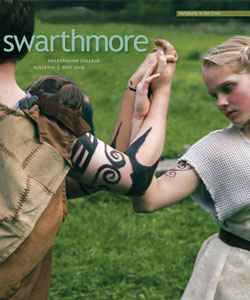The Liberal Arts Engineer
Ideas from many worlds come together in Swarthmore’s Engineering Department.
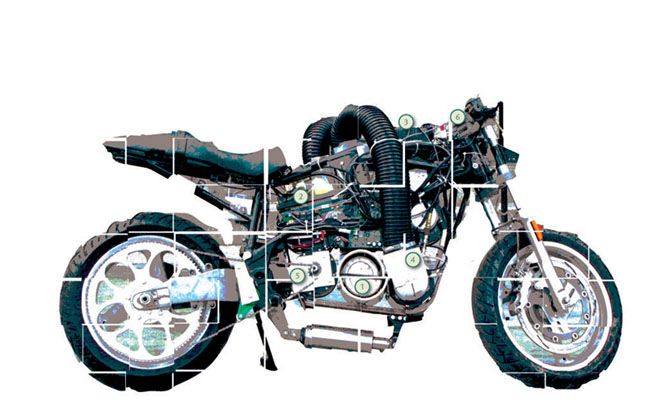
A HYDROGEN-POWERED MOTORCYCLE 1) Hydrogen is stored in two cylinders. 2) The hydrogen is pumped to the fuel cell, where it is converted into electricity. 3) The current is sent to a regulator and converter. 4) Excess heat from the fuel cell is pumped back to heat the fuel. 5) These gears turn the wheels, moving the bike. 6) A control panel shows speed, hydrogen pressure, and other information—all of which can be downloaded to a computer.
.
.
THE SECOND FLOOR LOBBY OF HICKS HALL, home of the College’s Engineering Department is a bright and friendly place. Light cascades from a wall-sized window onto a loose arrangement of plants, old instruments, and antique equipment. Between classes, animated groups of budding engineers cluster around a large table, socializing with classmates, friends, and professors; doing homework; eating lunch; or relaxing. Two young men are stretched out on a pair of long leather couches, fast asleep. They seem to be smiling as they nap. In a department legendary for its rigor, little of the stress associated with being an engineering student is in evidence here.
How can this be? What makes Swarthmore engineers so darned happy?
For some, the answer lies in the Hicks basement, at first glance not a particularly inviting place—well, except to engineers. Here, weak natural light oozes through high windows along one wall into a large teaching laboratory.
To the uninitiated, most objects in the space are slightly intimidating—torpedo-shaped tanks of helium, argon, and compressed nitrogen; engines and like parts lying about; a large duct attached to a wooden platform (future hovercraft); and a large hook on a thick chain hanging from the ceiling.
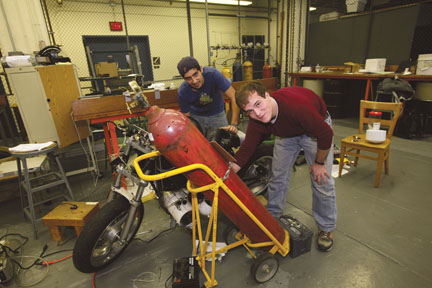
For two years, Andres Pacheco ’09 (left) and Alex Bell ’09 spent hours thinking about, tinkering with, and testing their senior design project—a hydrogen– fuel-cell powered motorcycle. Only one other vehicle like it exists—in London.
It’s here that, for the past two years, Alex Bell ’09 and Andres Pacheco ’09 have spent hours thinking, tinkering with, and testing their senior design project—a hydrogen– fuel-cell powered motorcycle (watch: hydrogen-powered motorcycle in action). According to their research, only one other vehicle like it exists—in London.
As motorcycles go, the bike isn’t pretty, but it is impressive. Onto a frame that Bell pulled from a junkyard, the two students installed a polymer–exchange-membrane fuel cell with a maximum output of 1.2 kilowatts. Hydrogen passes to the fuel cell, where it’s converted into electricity and sent to an AC induction motor that produces 1.6 horsepower, driving chain-linked sprockets that power the bike.
“We decided to make a motorcycle because the fuel cell, which is only 1.2 kilowatts but nonetheless very expensive, is too weak to drive a car,” Pacheco says.
Typically, Bell says, hydrogen-powered vehicles store the gas at very high pressure in tanks that, if ruptured, can result in catastrophic explosions. Bell and Pacheco opted to use a storage method that is both safer and more compact. Hydrogen is stored at low pressure and minimal volume in cylinders containing a combination of lanthanum, nickel, and aluminum. The metals react with the gas to form a hydride, which, when heated, releases pure hydrogen needed by the fuel cell. A unique feature of Bell and Pacheco’s design is the use of excess heat from the fuel cell to release hydrogen from the metal hydride. This is done via ducts that resemble laundry dryer vent tubes.
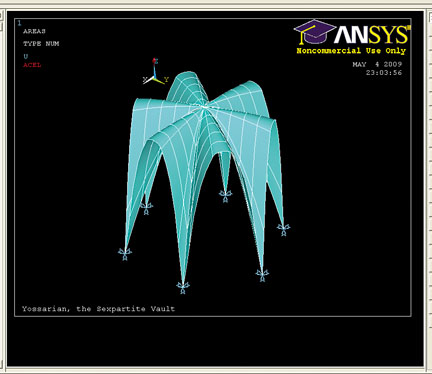
THE VAULTS OF BEAUVAIS: Kara Peterman ’09 investigated the unusual use of sexpartite (six-part) vaults in Beauvais Cathedral in France, built after the original quadripartite (four-part) vaults collapsed in 1284. “Four-part vaults are more structurally efficient and do a significantly better job of distributing load than their six-part counterparts,” Peterson says. “Medieval masons figured this out as well. Beauvais is on the World Monument Fund’s most endangered list because strong winds from the English Channel threaten the cathedral’s stability. Various heavy-handed restoration attempts have placed it in an even worse situation.”
Bell and Pacheco had a whale of a time in the lab, hovering over the bike, pondering, consulting, adjusting, and joking around. They even got to ride their project! During a first trial run in a nearby parking lot in December, the bike attained a speed of 15 m.p.h. and ran for 60 minutes—not fast and not for long—but the system worked.
Having built the bike prototype, Bell and Pacheco compiled a report on the efficiency of the fuel cell compared with internal combustion engines. A summary of their efforts was presented at an international fuel cell conference in June. They also designed and built a test stand to enable future engineering students to conduct experiments with the fuel cell and metal hydride storage containers.
Now that graduation is behind him, Pacheco, who pursued a double major in engineering and economics, will seek a job in the energy efficiency or renewable energy sector. Bell, an engineering major—who also took courses in computer science, philosophy, political science, and “whatever looked interesting”—will pursue a master’s degree in electrical engineering at Columbia University.
Their undergraduate experiences were defined by a number of factors they believe are unique to Swarthmore’s Engineering Program. They also have some advice for future engineers.
As freshmen and sophomores, both Bell and Pacheco worked with Nelson Macken, the Howard N. and Ada J. Eavenson Professor in Engineering, on the College’s longstanding hybrid electric vehicle project.
“When that work phased out,” Bell says, “he asked what we were thinking of next. We expressed interest in the efficiencies of fuel cells, came to him with a proposal, and worked with him for the past two years on this. Professor Macken has been one of the main reasons why this project has been such a success.
“The department’s small size and the openness of the faculty are among its greatest assets,” Bell says. “Our success with the motorcycle was due to the enthusiasm and countless hours of time given by members of the faculty and staff. Engineering students at Swarthmore should make a point of working with a faculty member each semester. Each has an interesting research focus, and working on their interests will help you find your own.”
.
MACKEN TAUGHT ENGINEERING AT CARNEGIE MELLON UNIVERSITY and at Rensselaer Polytechnic Institute (RPI) before coming to Swarthmore, where he’s been for the past 32 years. Having worked at two larger institutions, he’s able to appreciate the advantages for both faculty members and undergraduates of being at a school like Swarthmore. Macken admits that he knew little about fuel cells before joining Bell and Pacheco on the bike project. But with a small faculty, professors often must go beyond their areas of specialty, during which they often learn from the students, he says.
With no graduate programs, Swarthmore’s engineering undergraduates can enjoy their professors’ full attention—and benefit from departmental resources. The department bought the fuel cell system for the motorcycle. (Once the project was complete, the bike was dismantled to allow the fuel system to be reused in other College projects.) They also received project support from the Halpern Family Foundation Engineering Design Fund. Macken says: “It’s highly unlikely that this would ever happen at institutions with graduate programs, because much of the focus is on graduate research that typically attracts funding.
“At Swarthmore, we can feed a lot of what we learn from our research into our curriculum. We treat students here as we might treat graduate students at other schools—using them as our research assistants,” says Macken. In many cases, such student-faculty collaboration leads to co-authorship in scholarly publications.
ENGINEERING MAJORS MUST TAKE AT LEAST 12 COURSES IN THE DEPARTMENT—seven required (one of which is E90, where students choose a senior project) and five electives—as well as 20 nonmajor courses. Such a wide distribution of courses has significant benefits, especially at a college where the nonmajor offerings are so varied and rich, Macken believes. Living and working in an increasingly global society demands versatility, effective communication, and understanding of other peoples and cultures. “It’s obvious that if you want to be a successful engineer, a large part of what you do is dealing with people,” he says.
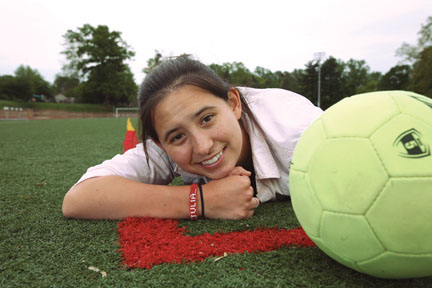
Julia Luongo ’10 is already thinking about a possible E90 project for next year. After reading about the Rotterdam dance club WATT, whose floor contains concealed piezoelectric components that react to the pressure and vibrations of dancers’ feet and produce electric energy to power the club’s light shows, Luongo is considering producing a prototype tile that reacts in the same way and comparing it to similar energy-producing systems that use solenoids and magnets.
Engineering major Julia Luongo ’10 knows all about dealing with people in a competitive environment—teammates and opponents—as a member of the Garnet women’s soccer team. In Professor of Engineering Fred Orthlieb’s Engineering Materials course, she’s been able to combine her love of soccer with her passion for engineering. Observing the difference in rolling speeds of soccer balls on artificial turf and on grass, Luongo created a project aimed at altering the surface friction of a soccer ball to compensate for the less resistant artificial surface of the Garnet home field, which, she says, allows the ball to roll faster than the longer, more resistant grass on most opponents’ fields. “A ball rolling or being dribbled on grass behaves quite differently from one on artificial turf.”
In order to create a ball that mimics on turf the behavior of a standard soccer ball on grass, she used four test balls that varied according to weight and outer-surface covering. After altering their surfaces by shaving, sandblasting, or removing the outer layer of material, she tested them for speed on turf.
“First, I determined the sliding co-efficient of friction of the ball on turf—although, technically, the ball isn’t sliding, it was a good enough measure of how the surfaces interacted. Then, I applied the same force to each ball to see how far each would travel and how it would slow down,” Luongo says.
The ball whose outer layer had been removed performed best, but “it was lighter than a standard soccer ball, and I needed to make it heavier without affecting the way it rolled,” Luongo says.
Seeking an expanding foam of some kind, Luongo came across Fix-a-flat™, a readily available foam substance used to temporarily seal punctures in car tires. “It worked well,” she reports. “It expanded, but you couldn’t feel that it was inside—and it made the ball heavier. It did slow down the ball, so it was the best choice, but all in all, it’s difficult to mimic the slowing effect of grass. That was the closest I got.”
.
PROFESSOR OF ENGINEERING LYNNE MOLTER ’79—departmental chair and the 28th female to graduate from Swarthmore’s Engineering Department—believes that Swarthmore attracts engineering students who are interested not only in their subject but also in ethics and helping others as well as pursuing studies in the humanities and social sciences.
“Between 2003 and 2007,” she says, 41 percent pursued double majors, combining engineering with economics, history, art and art history, computer science, music, religion, Spanish, mathematics, and various sciences. Not quite a third, she adds, minor in other subjects as well. “We’re very academically diverse,” Molter says, “and they can do all this in four years, which is not the case at most university engineering departments.”
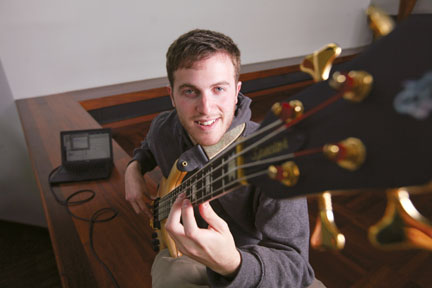
SMART JAZZ: For his E90 project, Dan Perelstein, also an honors music major, worked on developing an intelligent jazz accompaniment system, programming a computer to interact with a live bass guitar.
Senior Dan Perelstein is a music and engineering double major in the Honors Program. He began his senior year planning to develop an intelligent jazz accompaniment system, programming a computer to interact with live musicians in musically useful ways. The computer would make quick, informed musical decisions in response to the performances of its “bandmates” in order to “perform” as the fourth member of a jazz quartet by adding real-time piano accompaniment to live bass, drums, and saxophone players.
Perelstein’s initial idea, he says, turned out to be a little too ambitious. “I didn’t have time to get the program to respond to a full trio,” he says. “Currently, it only responds to the bass, but, fortunately, in a typical jazz setting, the bass provides the computer with enough information—both rhythmic and harmonic—to have an idea of where we are in the piece of music and what would be appropriate to play.”
Perelstein describes the engineering side of his life at Swarthmore as complex but “incredibly positive.” As a student of both engineering and music, he has experienced both disciplines as fiercely demanding and each department as having a strong sense of community. Although Perelstein was not initially attracted by the core requirements of engineering, his interest in music technology caught the attention of Professor of Engineering Carr Everbach (who plays trombone in the College orchestra).
“Professor Everbach realized that the department didn’t have a lot to offer in this relatively narrow field, so he put me in touch with Youngmoo Kim ’93, who had recently started a music technology lab at a nearby university.” For the last three years, Perelstein has worked with Kim on vacation-time projects, which have complemented his work at Swarthmore. “This has given me experience in the narrow field that interests me, which a school as small as Swarthmore couldn’t possibly offer formal classes in.”
.
THE DEPARTMENT ENCOURAGES THE SPIRIT OF COOPERATION AND COLLABORATION rather than competition, Molter says. At “Wizard Sessions,” which take place five evenings a week, student tutors, nicknamed “wizards,” provide academic help to anyone who needs it. Ann Ruether ’94, the department’s academic resource coordinator, organizes those students, making sure that they’re trained not just to provide answers but to help the students work through problems and find the solutions. “It is important for students to understand that we are committed to their success,” says Ruether. “Part of that commitment is providing them with the resources they need to do well in their courses. The Wizard Sessions provide a place where students can ask questions without feeling embarrassed or self-conscious because everyone who attends likely has the same or similar questions. The wizards who staff the sessions not only help with homework but also serve as a link between students and professors by giving feedback on what concepts students struggle with on their assignments. And important as providing homework help is, the wizards have done a fantastic job of getting students to work with one another to share their knowledge. Real learning comes from being able to explain something correctly to someone else.”
Engineering major Cecilia Jou ’11 says that some of her most rewarding experiences in the department have been during Wizard Sessions, where everyone collaborates on problems under the tutelage of upperclassmen. “These classes are just too challenging to struggle through alone, and everyone in the department is really supportive,” she says.
The peer-to-peer tutoring also extends to other required courses in mathematics, physics, and whatever other natural science courses the students need to obtain a degree in engineering.
Both Jou and Luongo (who is also a wizard) belong to another team of student academic mentors known as SAMs, or eSAMS in the Engineering Department. They mentor small groups of freshmen, with whom they interact regularly on both social and academic levels, giving advice as needed and organizing group lunches or other activities.
.
BEYOND THE REQUIRED COURSES, there’s really no fixed path to becoming an engineering graduate. But most students who arrive at Swarthmore at least entertaining the idea of a future in engineering—and a few who aren’t—take Engineering Methodology (E5) during their first semester, when first-year courses are taken on a pass/fail basis. Taught last fall by Professor of Engineering Erik Cheever ’82, E5 combines lectures by faculty or staff members on various aspects of the discipline with a series of projects of increasing complexity.
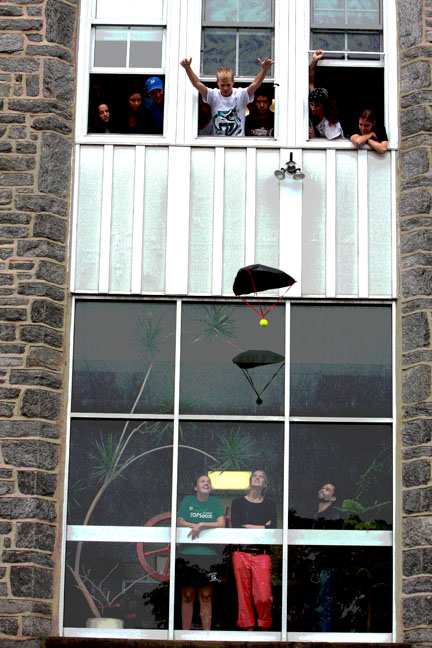
INTERPRETING THE RULES: Using a tennis ball, three dowel rods, a plastic trash bag, a roll of electrical tape, a paper clip, and three rubber bands, teams of freshmen in Professor Erik Cheever’s Engineering Methodology course designed and built devices aimed at keeping the tennis ball from reaching the ground for as long as possible after being dropped from a Hicks Hall window. This team built a parachute, but the winners triumphed with what Cheever described as “the most unique interpretation of the rules.”
The first project is a tennis-ball drop, for which teams of four or five students receive three dowel rods, a paper bag, a tennis ball, a plastic trash bag, a roll of electrical tape, a paper clip, and three rubber bands. Their task: to design and build a device that will keep the ball from falling to the ground for as long as possible when dropped from the roof of Hicks Hall.
Stormy weather on the due date drove this year’s ball drop from the roof into the second-floor lobby, where teams launched their devices from a window. The winning team relied not on air-resistance but friction. In what Cheever described as “the most unique interpretation of the rules,” team members punctured the tennis ball, drove two dowels through it to form an X-shape, then folded the electrical tape in half along its length, creating a 30-foot-long string, which they wound around the dowels. Holding the free end of the tape, they threw the device from the window and allowed the string to unravel from around the dowels—landing the tennis ball two stories below in 15.44 seconds, three times longer than any other device.
“It’s a half-credit course, so there’s not a lot of depth in what we do. It’s really just putting stuff together and getting it to work at a pretty basic level,” Cheever says. “One of the main themes of this course is learning to work together.”
Forty-four students signed up for E5 last fall. Each year at Commencement, typically about half that number graduate as engineering majors. Molter says that this is not completely unsurprising.
“We’re working on student retention in a number of ways, with Ann Ruether’s leadership in developing an even more extensive academic support system within our department,” she says. “That said, we’ll never retain 100 percent of the students initially expressing an interest in engineering. Students usually don’t study engineering in high school. If they’re good at math and science, their guidance counselors tell them to try engineering. For some students, it’s not really an informed choice.”
This year, 30 students earned bachelor of science in engineering degrees. Nine were double majors.
.
SOME COME TO ENGINEERING BY A CIRCUITOUS ROUTE. Karina Navarro ’09, an engineering major with a biology minor, arrived at Swarthmore uncertain of what she wanted to do but interested in exploring the sciences, especially environmental studies. “As a sophomore, I enrolled in the engineering course Water Quality and Pollution Control and found it the most useful class I’d taken so far,” she says. She decided to follow it with Mechanics, which she describes as “a fantastic class.” When the time to decide upon a major arrived, she realized she’d lost her heart to engineering but had heard it was impossible to begin that major later than freshman year. “I looked through all the requirements and found that I could do it if I took some math and physics courses during the summer,” she says, “so I submitted my plan to major in engineering.”
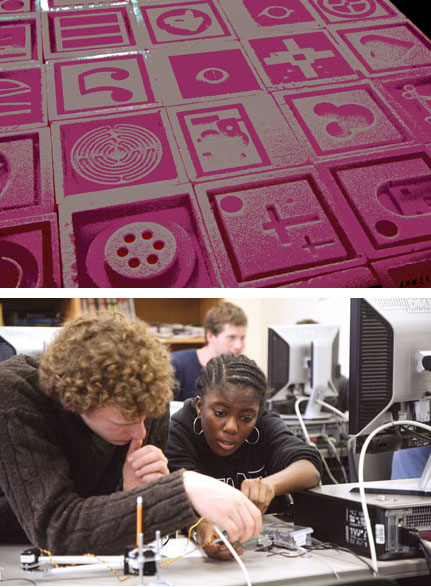
COMPUTERIZED DESIGN: Most E5 projects require the use of Solidworks, software that enables students to create, for example, patterns that are transferred via a milling machine onto pieces of Styrofoam (top), or program robot arms to perform writing or drawing tasks (bottom). To facilitate collaboration, their professor set up a Wiki site where students share information.
Navarro’s next two-and-a-half years were hectic. “The prerequisites are there for a reason, and I took many of them after the classes for which they’re recommended,” she says. And although the department does not encourage taking three engineering classes during any one semester, Navarro did that throughout her junior year.
Navarro’s senior project included making alterations to the storm-water modeling program StormWISE to include the possibility of purchasing easements for land parcels that are beneficial to the quality of the water, enabling StormWISE to recommend preventative action on water quality rather than merely being able to react to current water quality. She used the Little Crum Creek watershed as a testing ground. “I found that land conservation using easements is a cost-effective way of preventing further decline of water quality,” she says.
“One of the most rewarding things about engineering at Swarthmore is that if you work hard, the professors will go out of their way to help you,” she says. “When I asked Professor [Faruq] Siddiqui for permission to take Mechanics without having taken the prerequisite, he sent me home over winter break with two books, saying ‘just read them.’ When I was working on my Mechanics of Solids project that fall, he even drove me over to where I could get lumber.”
“Engineering at Swarthmore is great,” says Julia Luongo. With lots of support from students and faculty, the “residents” of Hicks Hall form a close community, and, busy as they are, they really do almost live in the department. With their own building, where everyone goes to work—and, yes, sometimes relax— students see friends and classmates all the time. It’s a place where everyone knows your name, she says.
 Email This Page
Email This Page